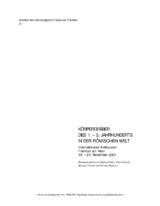Crematio et humatio in Hispania: Cordubensium mos
Autor
Vaquerizo Gil, Desiderio
Editor
Archäologisches MuseumFecha
2007Materia
Colonia Patricia Corduba (Córdoba, España)Yacimientos arqueológicos
Vías sepulcrales
Arqueología
METS:
Mostrar el registro METSPREMIS:
Mostrar el registro PREMISMetadatos
Mostrar el registro completo del ítemResumen
For many reasons the sources concerning death and burial in the Colonia Patricia Corduba remained almost unpublished until a few years ago. Today, we still have problems to find information on the Republican period. In contrast to that, we can be sure about the existence of large suburban cemeteries which followed the viae sepulchrales mirroring quite exactly the topographical and formal plan of the Urbs Romana. Like there, and contrary to the existing scholarly opinion, cremation and inhumation burials co-existed from the very beginning and the same situation can be observed at many other Hispanic towns. This possibly originates in traditions coming from various regions of Italy, or in some cases from different places in the Empire. Aus vielen verschiedenen Gründen blieben die Quellen zu Tod und Bestattung in der Colonia Patricia Corduba bis vor wenigen Jahren praktisch unveröffentlicht. Auch heute haben wir noch immer Mühe, Informationen zum republikanischen Zeitabschnitt zu finden. Im Gegensatz dazu herrscht für die Kaiserzeit Gewißheit über die Existenz großer vorstädtischer Gräberareale, die sich entlang von viae sepulchrales gebildet haben, welche ihrerseits schon jetzt recht genau den topographischen und formalen Entwurf der Urbs Roma wiedergeben. Im Gegensatz zur traditionellen Forschungsmeinung, bestanden dort Brandbestattungen und Körpergräber schon seit der ersten Stunde nebeneinander, und gleiches läßt sich in vielen anderen hispanischen Städten beobachten. Dies begründet sich möglicherweise auf Traditionen, die aus verschiedenen Regionen Italiens eingeführt wurden, und in einigen Fällen ebenso aus anderen Orten des Imperiums stammen mögen.

